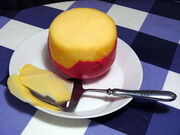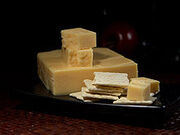Edam (Dutch Edammer) is a Dutch cheese traditionally sold in spheres with a pale yellow interior and a coat of red paraffin wax. It is named after the town of Edam in the province of North Holland, where the cheese is coated for export sale and for the tourist high season. Edam which has aged for at least 17 weeks is coated with black wax, rather than the usual red or yellow. Edam ages and travels well, and does not spoil easily; these qualities (among others) made it the world's most popular cheese between the 14th and 18th centuries, both at sea and in remote colonies. It is popular in North America, the Nordic countries, and many other countries around the world.
Most "young" Edam cheese sold in stores has a very mild flavor, is slightly salty or nutty, and has almost no smell when compared to other cheeses. As the cheese ages, its flavor sharpens, and it becomes firmer. It has a significantly lower fat content than many other traditional cheeses: as little as 28 percent of the cheese is made up of fat. Modern Edam is softer than other cheeses, such as Cheddar, due to its low fat content.
Mild Edam goes well with fruit such as peaches, melons, apricots, and cherries. Aged Edam is often eaten with traditional "cheese fruits" like pears and apples. Like most cheeses, it is commonly eaten on crackers and bread. Pinot gris, dry Riesling, semidry Riesling, Champagne, Chardonnay and Shiraz/Syrah are some recommended wines to accompany this cheese.
A major producer of Edam is the Friesland Foods company in The Netherlands. In the U.S., the May-bud brand is sold by the Churny Company, a subsidiary of Kraft Foods. A minor producer is the Mississippi State University Agricultural and Forestry Experiment Station, a research branch of the University.
In Spain and many Latin American countries, the cheese was long considered a delicacy. In the Mexican state of Yucatan, it is prepared as queso relleno (stuffed cheese). The piece of cheese is cut in half, leaving the protective paraffin cover. Then, most of the cheese is carved out and mixed with meat and vegetables, and put back into the paraffin shell. Finally, it is baked for a short lapse in an oven to melt the cheese. It is also the most common cheese used in the popular snack in the Czech Republic (Czech: smažený sýr) and Slovakia (Slovak: vyprážaný syr) where it may be served with a slice of ham (Slovak: so šunkou), and always with tartar sauce (tatárska omáčka) or mayonnaise. In the Philippines, it is named queso de bola, and is especially popular during Christmas season, served with hamon during the midnight meal (nochebuena).
In popular culture[]
Edam has been treated dramatically and humorously in a variety of cultural art forms. In the novel All Quiet on the Western Front, the main character believes its red outer covering is a sign of impending death. It is a wine flavor nuance in Sideways and an object of desire in the animated film Shopper 13. The book title East of Edam appears in the movie Curse of the Were-Rabbit. Edam is a seriocomic pivot in the Australian film Three Dollars. Actor Jason Flemyng advertised Edam in the UK. Edam was tested by the Mythbusters in episode 129 for its putative suitability as cannon ammunition against a ship's sail, but it bounced off the sail without damaging it.

Edam cheese

Edam cheese